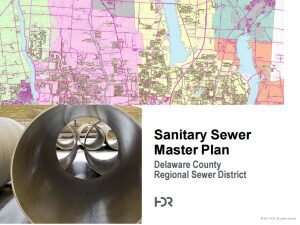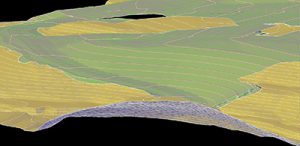Kleingers Plans for Utility Connection Under Streetcar Power Lines
The Kleingers Group recently created plans for the first underground utility connection installed under the new Cincinnati Streetcar while the overhead lines are energized.
Specifically, the Water Service Branch Plan created by Kleingers identifies the routing of a new water service line and the location of the bore pits required to tunnel under the streetcar line.
Like most projects in an urban setting, the routing of the new waterline had to be configured in a tight space while avoiding a number of existing utilities, all at various depths. The location of the bore pits also had to be chosen carefully to work around a large number of existing utilities.
The new water line, installed by Greater Cincinnati Water Works, will service a building currently under renovation by 3CDC.
Plans submitted to Greater Cincinnati Water Works were approved the same day, allowing work to begin quickly.
The project is expected to be the first of many to come that will require extra care to work around the tracks for the Cincinnati Streetcar.
Developers Input Wanted on New Delaware County Sewer Master Plan
Delaware County is currently conducting a series of public meetings to gather input before they start revising their sanitary sewer master plan. The Kleingers Group recently attend the meetings and is encouraging area developers to get involved.
Two things to note:
- The county is currently looking for input from developers. The new master plan will affect sanitary sewer plans and development throughout the county. If you are a developer who works in Delaware County, now is a great time to voice your opinions about what you would like to see happen before the planning process gets underway.
- Delaware County is also looking for information about specific projects to incorporate into the plan. They intend to consider existing and future developments as well as economic conditions, affordability, funding, and infrastructure assessments in developing the master plan. Understanding your plans for the future can assist the county in developing the best master plan.
 Getting involved is easy. There is a public meeting tomorrow, Thursday, Aug. 20 at the Frank B. Willis Government Building on US 23 North or you can submit your feedback online at www.co.delaware.oh.us/sanitary. You can also find a link to the meeting presentation here.
Getting involved is easy. There is a public meeting tomorrow, Thursday, Aug. 20 at the Frank B. Willis Government Building on US 23 North or you can submit your feedback online at www.co.delaware.oh.us/sanitary. You can also find a link to the meeting presentation here.
We’ll try to keep you informed as new developments happen, but getting your feedback in early is important so it can be considered as the county develops the plan.
Project Spotlight: Conceptual Grading Plan into a Real World Model
When Joseph M. Allen, PE, PS of Development Planning, Inc. hired The Kleingers Group, he already had a conceptual grading plan in place and knew what he wanted to achieve for Greenshire Commons, a new subdivision on Cincinnati’s West Side.
But there were still some major details to work out. The plan for the 170-acre subdivision included moving more than 300,000 cubic yards of dirt and building a 15-foot wall more than 300 feet long at the entrance of the subdivision.
The Kleingers Group helped Allen turn his vision for the site into reality by ensuring jurisdictional standards were met, while still moving forward quickly.
The primary goal for The Kleingers Group was to ensure an earthwork balance on the site – meaning no dirt would have to be taken off-site or brought in – while still meeting Allen’s goals for the terrain.
The Kleingers Group used Autodesk Civil 3D to both design and model the proposed terrain surface, providing not only the earthwork calculations but also provide a visual representation of the plan.
First, the roadway profiles were designed to meet both jurisdictional standards and the aesthetic requirements, hitting critical elevations as determined by the Allen. Then tools within Civil 3D allowed The Kleingers Group to model the roadways, sidewalks, walls, and green spaces along the roads. With this foundation in place, Kleingers was able to design the lot grades to accommodate different housing types while honoring drainage requirements and desirable driveway grades.
By using 3D modeling, The Kleingers Group was able to present images that made the suggested terrain easier to visualize and give very specific ideas about the final aesthetic. After each draft, The Kleingers Group worked with Allen to make changes to the grading plan to ensure his goals were met.
Once the systematic design was in place, Kleingers was able to adjust the entire design as requested in a small amount of time.
The final plan includes some dramatic changes to the terrain, including the 15-foot wall at the entrance.
By utilizing Kleingers to work out the details on this small but important piece, Allen was able to move forward quickly while still ensuring his goals for the site were met.
Sharing Engineering with the Next Generation
Here at Kleingers, we love to talk about engineering.
“It sounds a little corny, but I do believe I was born to be a civil engineer,” our Vice President of Operations Steve Korte recently said.
But while many of our engineers learned their passion from their dads or someone influential in their lives, we know not every kid has that opportunity—which is why our second passion is sharing our zeal for the profession.
As Engineering Week comes to a close, we are celebrating sharing engineering with the next generation.
“So many children today have no idea what we do, what an engineer looks like, what it takes to be an engineer. They have no idea that to build anything, you need an engineer. The sidewalk they walk on, the school they sit in, the roads they bike on, that’s all because of an engineer,” Director of Engineering Tim Casto said. “I hope maybe, just maybe, there is that one kid out in the room that sees these props, looks at our plans, and thinks maybe I could do that.”
For the past three years, Jim Kleingers and Ameen Bakare have participated in a program through the Dayton Chamber Minority Business Partnership to introduce engineering design, architecture, and construction to students at Thurgood Marshall High School.
According to Ameen, the program helps kids understand how each of the individual professions works together to build new construction. As part of the program, kids are broken into teams and take on the role of surveyor, architect, landscape architect, or program manager. The kids work together on a deadline to figure out the information needed from a survey, building placement, how to arrange a site, and how to coordinate a project.
Although the program is brief, Ameen said he hopes it gives kids a chance to think about engineering as a future profession and put a face to the profession.
“A lot of the kids that are part of Thurgood Marshall… they don’t really see a lot of engineers and whether it is because I am a little younger or a man of color, it is good to see another face they can relate to,” Ameen said.
The transportation group at Kleingers is working to create a similar program with Safe Routes to Schools and Steve recently began speaking at his former junior high school, which is now a middle school, through the Cincinnati Engineering Enhanced Mathematics and Science Partnership at the University of Cincinnati.
“It is a little selfish, but it is hard finding civil engineers,” Steve said. “But really I’m trying to help younger kids learn about a potential career. I hope they will take classes and pursue engineering in general.”
Steve said as part of the program he helped kids layout an island, which included making decisions about where everything should go. They also talked in class about what is important in a roundabout.
Additionally, Jim and Tim have facilitated the Webelos Cub Scout activity to several Cub Scout Packs in Butler County, introducing Webelos to engineering. Among other activities, kids learn about the types of bridges and draw examples of them, work with ropes and pulleys, learn about surveying and measuring a property line, and visiting a construction site.
Tim said he particularly enjoys showing kids props—including pavement cores—and he is currently looking for ways to tie in Minecraft into educational programs.
“Most kids today have played with the program and they are in essence creating a model of a “site”, something we do as engineers. In the game, they create houses, roads, trails, tunnels, waterways, beaches—stuff that engineers do every day. You can show a surface model in AutoCAD to a kid and they don’t get it, but if you relate those lines to the building blocks to Minecraft, that’s an “aha” moment for them,” Tim said.
